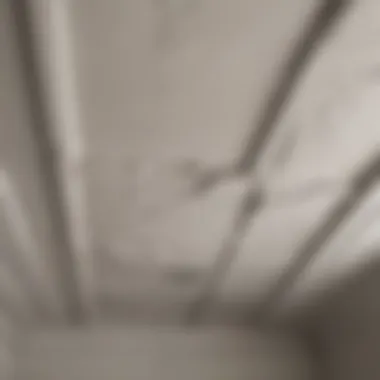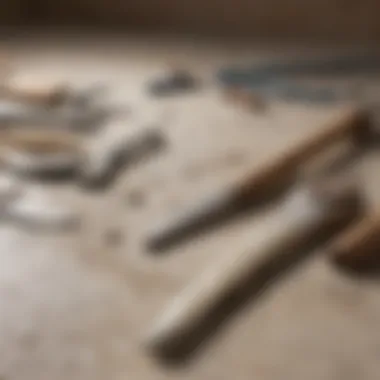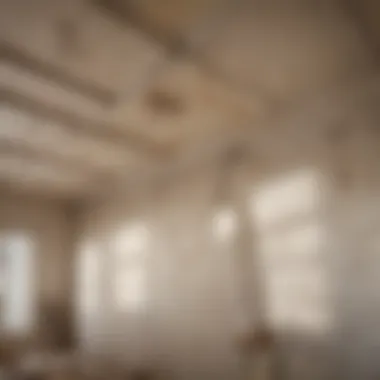Understanding Plaster Ceiling Repair Costs


Intro
When it comes to home renovation, plaster ceiling repair is often an overlooked aspect. Many homeowners may not realize how essential maintaining the plaster ceiling can be for both aesthetic appeal and structural integrity. This article delves into the various costs associated with plaster ceiling repair, addressing factors such as labor, material prices, and geographical variations. Understanding these elements can empower homeowners to make educated decisions about their repair projects.
Design Inspirations
A well-maintained plaster ceiling can serve as a focal point in a room, offering character and sophistication. Choosing the right design elements gives a unique touch to the space. Here, we will explore some trending styles and color palettes that can transform a plaster ceiling into an elegant feature.
Trending Styles
- Ornate Moldings: Adds a touch of classic elegance to traditional interiors.
- Minimalist Design: Simple lines and subtle textures appeal to modern aesthetics.
- Textured Finishes: Examples include skip trowel or lace patterns for a rustic feel.
- Geometric Patterns: Utilizing shapes can bring a contemporary look, aligning with modern decor.
Color Palettes
Choosing the right color palette is crucial when painting or repairing your plaster ceiling. Colors affect how light and space are perceived. Here are some effective palettes:
- Soft Whites and Off-Whites: Create an airy, open feel.
- Subtle Pastels: Introduce soft colors for a warm, inviting ambiance.
- Bold Colors: Darker shades can create a dramatic effect but should be used with caution.
- Contrasting Trim: Using a contrasting color for moldings can enhance the architectural details.
Remember that the choice of colors and designs should naturally harmonize with the rest of the interior decor.
Maintenance and Upkeep
Regular upkeep is vital for prolonging the life of plaster ceilings. A proactive approach can save homeowners from costly repairs down the line.
Seasonal Maintenance Checklist
To maintain your plaster ceiling effectively, consider the following tasks throughout the year:
- Spring: Check for water stains from winter storms.
- Summer: Ensure proper ventilation to reduce moisture.
- Fall: Inspect for cracks or damages that may need attention before winter.
- Winter: Keep humidity levels low to prevent mildew growth on plaster.
Cleaning and Organization Tips
Cleaning and caring for plaster ceilings can be straightforward. Use these tips to keep it looking fresh:
- Dust Regularly: A soft broom or duster can remove dust and cobwebs without damaging the surface.
- Spot Clean Stains: Use a damp sponge with mild detergent. Avoid excessive moisture.
- Protect Fixtures: When cleaning, ensure light fixtures are well-covered to prevent damage.
Overview of Plaster Ceilings
Understanding plaster ceilings is essential for homeowners and property managers alike. These ceilings not only add character to a home but also reflect the era in which the structure was built. Knowing the characteristics and common issues associated with plaster ceilings helps in making informed decisions regarding maintenance and repair. The aim of this section is to provide a foundational understanding of plaster ceilings, shedding light on their unique features and potential challenges.
Characteristics of Plaster Ceilings
Plaster ceilings are primarily made from a mixture of gypsum, lime, or cement. They are often appreciated for their durability and aesthetic appeal. Some key characteristics include:
- Texture: Plaster can be smoothed or shaped into various patterns or designs, allowing for a unique finish that can enhance the overall decor.
- Sound Insulation: The density of plaster provides excellent sound insulation, which is an advantage for noise-sensitive areas in a home.
- Fire Resistance: Plaster has natural fire-resistant properties, adding an extra level of safety.
- Longevity: When maintained properly, plaster ceilings can last for many decades without the need for replacement.
However, these characteristics also mean that repairs can be complex. Knowing this ahead of time can prepare homeowners for potential costs and complications.
Common Issues with Plaster Ceilings
Despite their advantages, plaster ceilings can develop several issues over time. Common problems include:
- Cracks and Chips: These occur due to settling of the building or temperature changes. They may start small but can widen if not addressed.
- Water Damage: Leaks from plumbing or roof issues can cause plaster to bubble or stain, leading to the need for serious repair.
- Loosening: Over time, plaster can become loose, especially if it was applied over drywall. This can create an unsightly appearance and may pose safety risks.
- Mold Growth: If moisture remains trapped, mold may develop within the plaster, requiring remediation.


"Being proactive about identifying and addressing common issues can extend the life of your plaster ceilings considerably."
Homeowners should be observant and conduct regular inspections to catch these problems early. Addressing them promptly can ultimately save money in repairs and preserve the beauty of these unique fixtures.
Cost Factors in Plaster Ceiling Repair
Understanding the cost factors in plaster ceiling repair is essential for homeowners and anyone involved in interior design. This knowledge will help you anticipate expenses and navigate the decision-making process skillfully. Repair costs can vary significantly based on several elements, including the type of damage, material costs, labor rates, and geographic location. Each of these aspects plays a crucial role in the overall expenditure for plaster repair work, thus informing your budget and expectations.
Type of Damage
The extent of damage to a plaster ceiling directly impacts repair costs. Minor damage such as small cracks or chips can often be repaired quickly and inexpensively. Moderate damage, which may involve larger cracks or small sections of plaster failing, requires more materials and time. Extensive damage, such as large areas of the ceiling collapsing or a significant water intrusion, necessitates a complete overhaul, driving costs up further. It's vital to assess the type of damage before getting quotes so that homeowners can understand the scope and limitations of potential repairs.
Material Costs
Material costs are an important consideration when calculating the overall expense of plaster ceiling repairs. Various materials may be required, including different types of plaster, patching compounds, and any necessary tools. Oftentimes, standard materials like joint compound or established brands of plaster such as USG or BPB will suffice. However, high-quality materials may also be necessary for more complex repairs, which can lead to increased costs. Be sure to ask contractors for a detailed breakdown of the material costs, as these can fluctuate widely based on quality and availability.
Labor Costs
Labor costs contribute significantly to the overall expenses involved in plaster ceiling repair. The hourly rates charged by contractors can vary based on their experience and expertise. On average, skilled professionals might charge anywhere from $50 to $100 per hour, depending on regional variations. Understandably, higher rates may reflect higher quality of work and craftsmanship. Furthermore, if the repair entails extensive labor or specialized skills, homeowners can expect to pay more.
Geographic Location
Geographic location has a notable influence on repair costs. Urban areas typically experience higher labor rates due to increased demand and cost of living. Conversely, rural areas may offer more competitive pricing due to lower overhead costs. Additionally, availability of skilled labor in your location can affect the overall pricing structure. Homeowners should research local contractor rates and geographical trends to gain a more precise understanding of what to expect regarding costs. This can ultimately help in making informed decisions regarding your plaster ceiling repairs.
"Assessing the cost factors in plaster ceiling repair is not just about numbers; it's about understanding the value of quality repair work and its long-term benefits to homeowners."
Considering these cost factors provides a clearer picture of what to expect financially when executing repairs on plaster ceilings. Awareness of the key elements allows for better planning and decision-making, ensuring that you're well-prepared for the project ahead.
Types of Plaster Repairs
Understanding the various types of plaster repairs is crucial for homeowners. Each type comes with different implications regarding cost, time, and complexity. Identifying whether your ceiling requires minor, moderate, or extensive repairs can save both money and effort in the long run. Repairs might seem straightforward, but the nature of the damage can drastically alter the scope of work needed to restore the plaster ceiling.
Minor Repairs
Minor repairs are often characterized by superficial issues that do not compromise the integrity of the plaster ceiling. Common examples include small cracks or blemishes that generally result from normal settling of a home over time. These issues can often be addressed quickly and at a lower cost.
- Cost Implication: The cost for minor repairs is typically low. Homeowners can expect to spend around $100 to $300, depending on the extent of the damage.
- DIY Potential: Many minor repairs can be handled by homeowners themselves, provided they have the right tools such as a trowel and some plaster patching compound. Doing it yourself can save on labor costs while providing a sense of accomplishment.
Moderate Repairs
Moderate repairs involve more significant issues compared to minor repairs. These might include larger cracks, loose plaster, or small sections that have begun to detach from the ceiling. Moderate repairs often require some preparation work and potentially the need for additional materials.
- Cost Factors: Homeowners should prepare to spend between $300 to $600 on moderate repairs. The total cost can fluctuate based on labor rates and material prices.
- Necessary Tools: In addition to patching compounds, savvy homeowners might need a few other tools, like a putty knife and possibly some sandpaper for finishing.
Extensive Repairs
Extensive repairs occur when the damage to the plaster ceiling is severe. This could be due to long-term neglect, water damage, or other structural issues. In such cases, it may be necessary to remove and replace larger sections of the ceiling.
- Investment Required: The cost for extensive repairs can soar, often ranging from $600 to upwards of $1,500. This variance is largely due to the complexity of the work and the materials involved.
- Professional Help: It is advisable to hire professionals for extensive repairs. Their expertise can ensure that the repairs restore the ceiling to a safe and aesthetically pleasing condition.
Repairing plaster ceilings, especially extensive damage, demands careful evaluation and skilled labor for best results.
By having a good understanding of the types of repairs needed, homeowners can make informed decisions. Assessing the damage accurately is the first step in determining the necessary level of repair and its associated costs.


Estimating Costs
Estimating costs associated with plaster ceiling repairs is critical for homeowners and professionals alike. It sets the foundation for budgeting and planning. Understanding costs ensures that there are no surprises along the way. Ignoring this step may lead to financial strain or project delays. By analyzing specific elements such as labor and material costs, one can develop a clearer picture of the overall expenditure.
Considering different repair types is crucial. Minor patches will cost less than full replacements, for instance. Also, geographical factors influence pricing. In some areas, labor costs are higher due to demand or regional living expenses.
When estimating costs, thoroughness is key. Homeowners should assess their unique situation. Take into account the age of the ceiling, extent of damage, and local market conditions. Gathering quotes from various contractors can provide insights into reasonable price ranges.
In summary, being informed and methodical about cost estimation can make a significant difference in managing plaster ceiling repairs effectively.
Average Repair Costs by Type
Repair costs for plaster ceilings can vary widely depending on the type of damage and the required intervention. Generally, the following can be noted:
- Minor Repairs: Minor repairs usually range from $200 to $500. This includes simple crack fills or small patch-ups.
- Moderate Repairs: Moderate repairs may cost between $500 and $1,200. These repairs often involve larger damaged areas needing re-plastering or additional smoothing out of existing plaster.
- Extensive Repairs: Extensive repairs can range from $1,200 to $4,000 or more. Situations like large sections of ceiling requiring complete replacement fall into this category.
Understanding these averages helps homeowners plan their budget more effectively.
Price Breakdown
A thorough price breakdown is essential for anyone considering repairs to plaster ceilings. Factor in every element to fully understand potential costs:
- Labor Costs: Professional labor typically constitutes a large part of the expense. Skilled plasterers often charge between $40 and $100 per hour, influenced by experience and complexity of work.
- Material Costs: The materials used for plaster repairs can impact the overall budget. Basic plastering compounds cost around $15 to $30 for a five-gallon bucket, while specialized or high-quality products may be significantly more expensive.
- Additional Fees: Don’t forget to consider any additional fees that contractors might charge, like disposal of old materials or travel expenses.
Incorporating all these elements into an overall estimate can prevent miscalculations and ensure a smoother repair process. Remember, collecting multiple quotes is recommended for comprehensive insights.
By breaking down these costs clearly, homeowners can make well-informed decisions about their plaster ceiling needs.
DIY vs. Professional Repair
Deciding between DIY and hiring professional services for plaster ceiling repairs is a significant consideration for homeowners. Each option carries its own benefits and drawbacks, directly influencing both the outcome of the repair and the associated costs. Understanding these aspects can help ensure that the approach taken aligns with the homeowner's skills, time availability, and budget.
Benefits of DIY Repair
Choosing to undertake plaster ceiling repairs as a DIY project can be appealing for several reasons.
- Cost Savings: Doing the work yourself can significantly reduce labor costs, which often make up a large portion of repair expenses.
- Control Over the Project: Homeowners can manage the timeline at their own pace, tailoring the work to suit personal schedules and ensuring every detail meets their expectations.
- Skill Development: The process of repairing plaster ceilings can enhance DIY skills, making homeowners more capable for future projects.
- Personal Satisfaction: Completing repairs independently can bring a sense of achievement, having transformed a visible aspect of the home without outside help.
However, it's essential to weigh these benefits against the potential challenges that DIY repairs can pose. Homeowners must consider their experience, tools available, and the time they can commit to ensure a successful project.
When to Hire Professionals
While DIY repairs can be beneficial, there are certain situations where hiring a professional is advisable.
- Severe Damage: For extensive or severe damage, such as major cracks or structural issues, professionals have the expertise to ensure repairs meet safety standards and restore integrity.
- Lack of Time: If homeowners lack the time to devote to a repair, or if the project requires immediate attention, professionals can complete the work more efficiently.
- Complex Techniques: Some repair techniques can be more complex and require specific skills or tools which homeowners might not possess.
- Warrantied Work: Professional services often provide warranties for their work, offering peace of mind should issues arise post-repair.
In summary, whether to pursue a DIY repair or hire professionals depends on various factors including the extent of damage, personal skills, and time constraints. Each path offers distinct advantages that can be capitalized upon if chosen wisely.
Ultimately, it is prudent for homeowners to assess their own capabilities and the specific damage present before making a decision.
Choosing the Right Contractor
Choosing the right contractor for plaster ceiling repair is crucial. A skilled contractor can ensure that the job is done effectively, within budget, and with high quality. On the other hand, hiring someone unqualified can lead to additional costs and poor results.


Here are key factors to consider when selecting a contractor:
- Experience: Look for a contractor who has substantial experience dealing with plaster ceilings. Their background in the field is important for problem-solving and expertise.
- References: A reputable contractor should be able to provide references from previous clients. Speaking to these clients can offer insight into their work ethic and professionalism.
- Licensing and Insurance: Verify that the contractor holds the necessary licenses to operate within your state or locality. Insurance protects you from liability in case of accidents during the repair process.
A well-chosen contractor reduces future repair risks and can save money over time.
Researching Credentials
Researching credentials is an important step that homeowners cannot overlook. Ensure the contractor’s qualifications are legitimate and align with the repair job needed. Here are some steps to undertake:
- Check Licensing: Visit local government websites to confirm that the contractor has the necessary licenses. Different regions have different requirements, so ensure they comply.
- Verify Insurance: Make sure that the contractor carries liability insurance and workers' compensation. This helps guard against potential injuries or damages during the repair.
- Look for Certifications: Some contractors may have additional certifications from industry bodies. This is often a sign of their expertise and commitment to professional standards.
By confirming a contractor's credentials, you can discourage potential issues and secure a reliable service provider.
Evaluating Quotes
Evaluating quotes is equally important when it comes to choosing a contractor. Do not just choose the lowest price; consider what is included in that quote. A thorough evaluation typically involves:
- Detailed Breakdown: Ask for a detailed quote that outlines materials, labor, and any other costs included. This helps you understand exactly what you are paying for.
- Comparison: Collect multiple quotes to compare. This will give you an idea of the market price for your repair needs.
- Inclusions and Exclusions: Understand what is covered within the quote and what may be excluded. Clear agreements help prevent misunderstandings later.
Remember to evaluate the overall value rather than just the price. The cheapest option may not always serve your best interests long-term.
Maintaining Plaster Ceilings
Maintaining plaster ceilings is a crucial topic for homeowners who wish to preserve the character and integrity of their homes. Plaster ceilings offer both aesthetic appeal and durability, but without proper care, they can deteriorate, leading to costly repairs. This section addresses the essential elements of maintaining plaster ceilings, focusing on routine inspections and preventive measures.
Routine Inspections
Routine inspections are vital for identifying potential issues early. Checking for cracks, bulging, or discoloration can prevent small problems from evolving into extensive damage. Ideally, homeowners should conduct these inspections at least twice a year.
When performing inspections, pay attention to the following:
- Visible Cracks: Even small cracks can indicate underlying issues. Monitoring their progression is essential.
- Water Damage: Look for stains or damp patches on the plaster. Water intrusion can weaken the structure and lead to mold.
- Dust Accumulation: Significant dust build-up can indicate a need for cleaning and may harbor pests.
A thorough inspection can save money in the long run. Early detection means repairs can be minor rather than extensive. Consider documenting findings and noting any changes over time.
Preventive Measures
Preventive measures can significantly extend the lifespan of plaster ceilings. Taking proactive steps is often less expensive than addressing problems after they occur. Here are some recommended practices:
- Control Humidity: High humidity can weaken plaster. Use dehumidifiers in areas prone to moisture, such as bathrooms and kitchens.
- Proper Ventilation: Ensure good airflow in your home. Stale air can lead to mold growth, which further damages plaster ceilings.
- Regular Cleaning: Gently dust plaster surfaces to prevent grime build-up. Avoid using abrasive cleaners that can damage the plaster.
- Addressing Leaks Promptly: Any sign of a leak should prompt immediate action. Fixing roof or plumbing issues quickly will prevent water damage to ceilings.
"Timely maintenance can help avoid costly repairs and ensure the longevity of your plaster ceilings."
By prioritizing maintenance, homeowners can enjoy the beauty and durability of their plaster ceilings for years. Engaging in routine inspections and implementing preventive measures not only preserves the aesthetic value of these ceilings but also contributes to a healthier living environment.
Closure
Final Thoughts on Repair Costs
Repair costs for plaster ceilings can vary significantly based on numerous factors. Each situation is unique, from the extent of the damage to the geographical location. For instance, simple cracks may require minor repairs, which are relatively inexpensive, while extensive deterioration can demand a complete overhaul, thus escalating costs.
It is crucial for homeowners to communicate effectively with contractors, ask detailed questions about pricing, and obtain multiple quotes. Understanding the breakdown of these costs will aid in making an informed decision. Homeowners should also consider the long-term benefits of quality repairs - investing in durable materials may lead to fewer issues down the road and save money in future repairs.
Importance of Timely Repairs
Timeliness in addressing plaster ceiling issues cannot be overstated. Delaying repairs can lead to more severe problems, such as mold growth or structural damage, which necessitates more extensive and costly interventions. Ignoring minor issues can turn a simple repair into a major renovation task, which could significantly increase overall expenditure.
Regular inspection and timely intervention help protect not only the aesthetic appeal of the home but also its structural integrity. Prioritizing repairs fosters a safe and pleasant living environment.
Ultimately, awareness and swift action can lead to savings, both financially and emotionally, as it reduces the stress often associated with unexpected home repairs.







